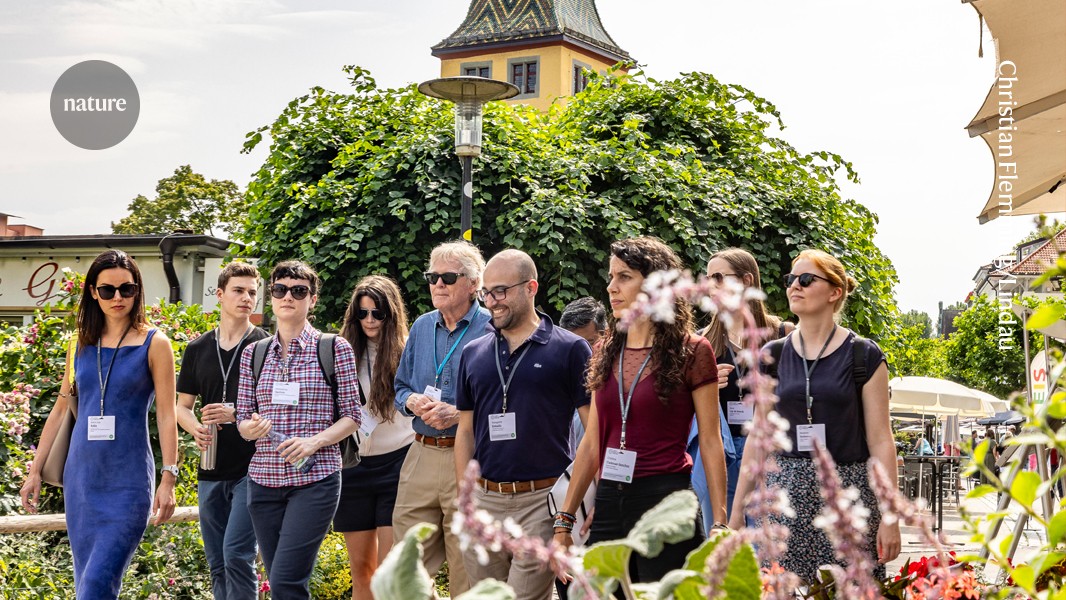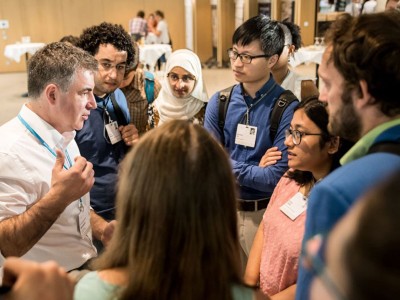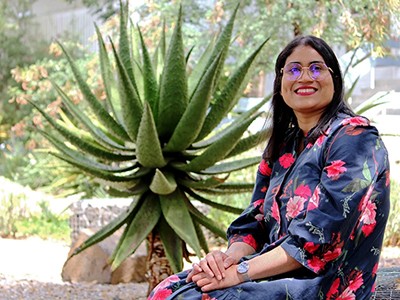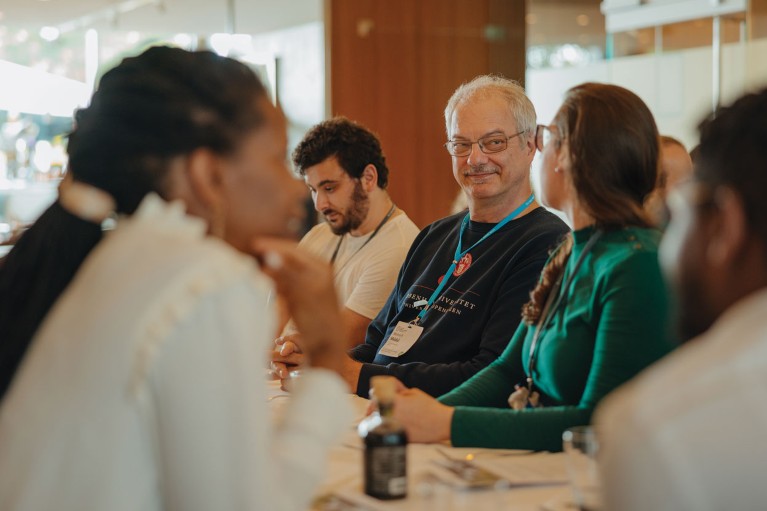
Nobel laureate Morten Meldal (with blue lanyard) has learnt from the young scientists at the 2023 Lindau meeting.Credit: Julia Nimke/Lindau Nobel Laureate Meetings
Each year, more than two dozen Nobel laureates attend a meeting in Lindau, Germany, at which hundreds of early-career researchers from all over the world can network with them and each other.
Attending the Lindau meeting is almost always a once-in-a-lifetime opportunity for the young scientists whom the organizers have selected from a pool of applicants representing undergraduates, graduate students and postdoctoral fellows. There is a notable exception to the ‘once only’ rule: early-career participants can come back to the conference if they go on to win a Nobel prize.
Eight career tips from Nobel Laureates
So far, just two individuals have returned to Lindau later in life as prizewinners. The most recent was in June 2023, when this Nature reporter attended the 72nd Lindau Nobel Laureate Meeting, and her travel was paid for by the conference organizers. It sparked an abiding memory that speaks to the spirit of Lindau as a cross-generational melding of minds: the sight of Nobel laureate Morten Meldal, drenched in sweat, boogieing on the crowded dance floor while grinning young scientists approached to ask, sheepishly, whether they could take a selfie, dancing alongside. Meldal, wearing a wide grin himself, happily obliged.
Meldal is perhaps more cognizant than most laureates of the meeting’s importance to early-career researchers (ECRs). He first attended as an ECR in 1986. In 2022, he, along with Carolyn Bertozzi and K. Barry Sharpless, won the Nobel Prize for Chemistry.
Meldal recalls his first visit fondly. “I got the opportunity to talk with some really clever people and it made a long-lasting impression on me,” he says. It never crossed his mind that he might be a future Nobel laureate. Chasing awards has never been his aim, he says, because he is “very much focused on the actual science”.
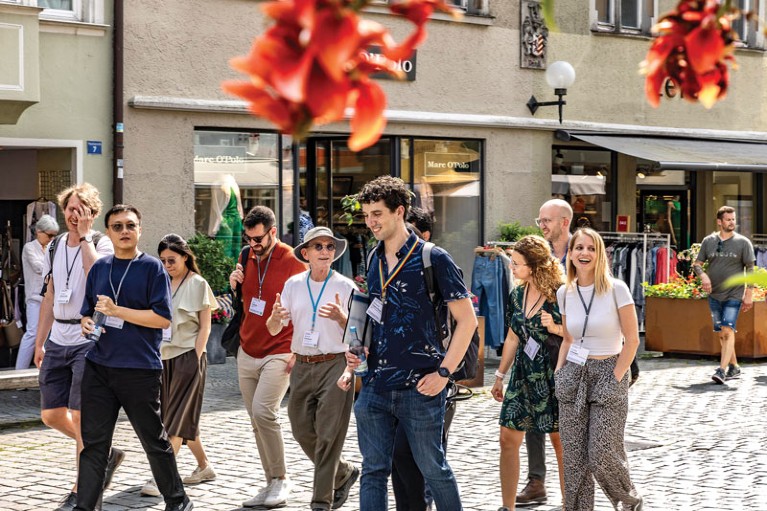
Science walks give Landau meeting attendees the chance to network informally.Credit: Christian Flemming/Lindau Nobel Laureate Meetings
Even if the opportunity to attend happens only once for most researchers, there is much to be gained from networking at an event that, since 1951, has drawn hundreds of global rising stars to assemble at Lindau. Meetings rotate between the disciplines of: physics; chemistry; physiology and medicine; and economic sciences, with an interdisciplinary meeting held every five years. The 2024 meeting, to begin on 30 June, will focus on physics.
Nature spoke to former Lindau young scientists to find out how attendees can maximize the benefits of spending a week in the company of some of the world’s brightest minds. The tips below would be useful for any meeting at which ECRs interact with more-experienced peers. Interviewees suggest planning ahead, signing up quickly for small-group interactions and preparing questions for the big-name speakers in advance. They also advise against continuing to work while at the meeting, and to not assume that the important conversations stop when formal sessions are over — nor that it’s always the ECRs who are picking up new wisdom.
Press pause
Attendees say they benefited from slowing down and being fully present for the Lindau experience. Trishla Sinha, an MD–PhD student at the University Medical Center Groningen in the Netherlands, studies the infant gut microbiome, and says she recommends staying with one of the families that host visiting scientists during the meeting. Feeling welcomed by a local family, Sinha says, sets the tone, and is particularly comforting for those who have travelled from the other side of the world. “Host families really help in making you feel at ease,” she says. Many Lindau host families volunteer enthusiastically year after year.
At the meeting, Sinha noticed many attendees trying to continue with their research. Her advice is: don’t. This, she says, is your one week to meet, network and collaborate with brilliant minds. “Just immerse yourself and block off time to talk to different people,” she says.
Sinha describes herself as an extreme extrovert who was in her element at Lindau. But everyone should seek ways to connect with other attendees, she advises. “Don’t just stay in your shell.”
Plan ahead
Astrochemist Divita Gupta attended the 2017 meeting. She was then in the fourth year of a combined bachelor’s and master’s degree at the Indian Institute of Science Education and Research Mohali, and recalls “jumping up and down” when she learnt she’d clinched a spot to travel, all expenses paid, to Lindau.
She kept an open mind in terms of preparation, says Gupta, now a postdoctoral researcher at the University of Cologne in Germany. Many of those who spoke to Nature said that planning ahead is key. Pratik Tawade, a PhD candidate in microelectronics at Delft University of Technology in the Netherlands, attended Lindau in 2023, and recommends signing up well in advance for sessions and workshops of special interest. Small-group sessions, such as science walks with a Nobel prizewinner and laureate lunches, fill up quickly. These opportunities are strategic because, at breaks between sessions, an enthusiastic throng of participants swarm the Nobel laureates and it can be hard to be heard in the herd.
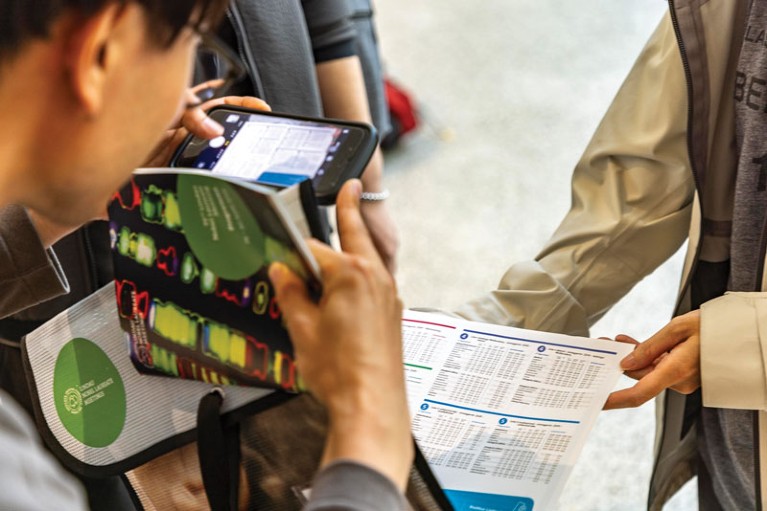
Landau attendees recommend registering early to secure a place in small-group sessions.Credit: Christian Flemming/Lindau Nobel Laureate Meetings
Apart from the formal sessions, “a lot of people hang out after the sessions, and it’s good to join them”, says Tawade. “The best ideas and science are often discussed over a cup of coffee or a beer.”
Tawade also recommends preparing questions for senior scientists, to elicit insights and recommendations for navigating academia or the professional world. Another 2023 attendee, biochemist Kamini Govender, a postdoc at the University of the Free State in Bloemfontein, South Africa, did similar groundwork. “Prepare questions for laureates you want to interact with in advance, so you’re not lost for words or too nervous to think of what to say when you meet them in person,” she says. Govender also gives some practical advice for coping with Lindau’s uneven, cobblestone streets: bring comfortable walking shoes.
Overcoming low vision to prove my abilities under pressure
Zebib Yenus Nuru, a materials scientist at Adigrat University in Ethiopia, says that attending the 2012 meeting helped her to tap into invaluable scientific infrastructure and networks. “African institutions lack cutting-edge scientific facilities for conducting experimental research,” she says. She overcame this obstacle by establishing collaborations with institutions in the United Kingdom, Canada, the United States and South Africa, allowing her “to access their facilities, use their expertise and expand the scope of my research”, she says. Although the meeting produced useful networking opportunities with ECRs with whom she exchanged ideas for a while after it ended, “regrettably, we disconnected at some point”, she says. However, she has started to reconnect with people through an online platform called the Lindau Mentoring Hub, launched in 2020. For example, Yenus Nuru attended a session on the platform about mid-career mentorship that included science, technology, engineering and mathematics (STEM) career coach Alaina Levine.
Raisa Sherif, a postdoctoral fellow in economics at the Max Planck Institute for Tax Law and Public Finance in Munich, Germany, is one of the co-founders of the mentoring hub. She says that the team wanted to emulate online the informal, but important, conversations that take place in the corridors of an institute or university. Lindau alumni can access the hub to discuss and troubleshoot topics ranging from writing scientific papers to forming collaborations.
Take chances, be courageous
Yenus Nuru needed to summon the courage to mingle with Nobel prizewinners. “Gaining a spot to attend the meeting was both an incredibly exciting and a terrifying experience,” she says. “Growing up in a small city in Ethiopia, where numerous challenges exist, and then being allowed to attend the meeting with laureates and experts from around the world was like a dream come true.”
Insights from four female scientists caught at the early-career crossroads
During the conference, Yenus Nuru interacted with researchers such as James Cronin, who shared the 1980 physics Nobel for his work on subatomic reactions, and Mario Jose Molina, who shared the 1995 chemistry Nobel for discovering that chemicals called chlorofluorocarbons damage the ozone layer. Yenus Nuru had several conversations with Cronin. “He showed a genuine interest in understanding my background as well as my current research interests and projects.”
Yenus Nuru learnt one profound lesson about failure: that groundbreaking research often emerges not only from careful design and implementation, but also from the willingness to make mistakes and learn from them. “This taught me to never give up, but instead to persistently work towards innovative solutions despite setbacks.”
Not all of the interactions with Nobel laureates were serious. Sinha was one of many who delighted in dancing alongside Meldal at the evening receptions, snapping a video with her phone to prove it. Sinha also felt fortunate to spend four hours talking to Meldal and his wife over dinner.
“He was such a down-to-earth guy. You could talk to him about anything — his family, his passions, he was a genuinely really nice person,” says Sinha. She admits she had expected Nobel prizewinners to be aloof. Sinha considers her opportunity to speak to Meldal’s wife, Phaedria Marie St. Hilaire, a pharmaceutical scientist in the biotechnology industry and an advocate for women of colour in STEM, to have been the most valuable interaction of the meeting. The two are still in touch. St. Hilaire comes from the Caribbean, and Yenus Nuru says the two of them discussed issues that women in STEM face and the problems St. Hilaire confronted as a woman of colour pursuing a STEM career in a European country.
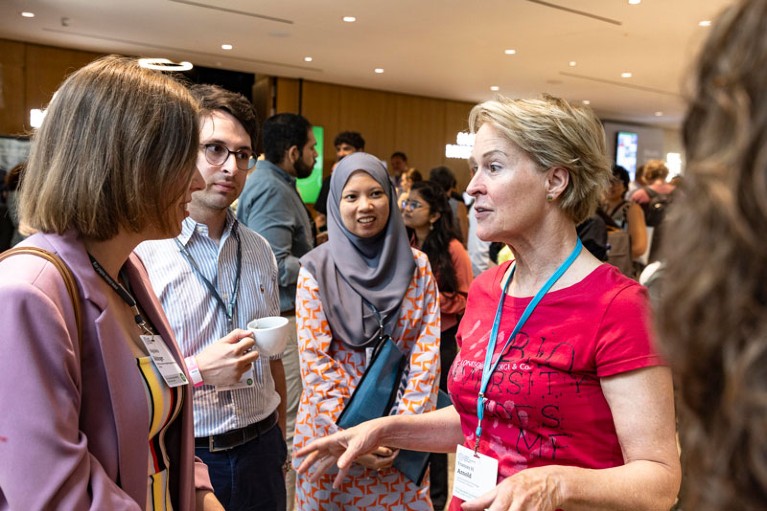
Past attendees advise crafting questions ahead of time to ask of laureates, such as Frances Arnold (right) at the 2023 Lindau meeting.Credit: Christian Flemming/Lindau Nobel Laureate Meetings
Immunologist Simon Gebremeskel, who attended Lindau in 2018 while a PhD student at Dalhousie University in Halifax, Canada, says he learnt a lot from formal and informal conversations with Nobel winners Ferid Murad, who showed how nitroglycerin expands blood vessels, and Randy Schekman, who discovered the molecular machinery that controls protein trafficking in cells, among other processes. “The most memorable thing about the Nobel laureates I spoke with is that all of them had experienced many years of being ostracized and faced a lot of hurdles in getting the scientific community to accept their work.” Many spoke about their work being repeatedly rejected, the difficulty of accessing research funding, and how perseverance ultimately paid off. “The other important thing one of them communicated was to make sure you enjoy what you do” as well as not neglecting your loved ones in your scientific journey, says Gebremeskel, who is now a senior scientist in Houston, Texas, at the immunotherapy company Synthekine.
Not all of the learning flowed from laureates to ECRs; some lessons went in the opposite direction. In 2023, an impromptu remark by 2002 Nobel laureate Kurt Wüthrich about feeling discriminated against as a man prompted one brave female ECR to call out his male privilege in the context of systemic discrimination faced by women in science, for which she was applauded. Following the incident, a visceral buzz among ECRs pervaded hallway discussions for the rest of the meeting.
For Meldal, the moment was an important lesson from the ECRs. “Today, there is a totally different way of seeing both diversity and gender issues than when we, as old laureates, were younger.” A few of the laureates “stepped into the nettles”, notes Meldal, referring to their insensitive remarks, adding that in interactions between generations “you should be careful when you step into their world”.
The Lindau meetings have been criticized in the past for glorifying Nobel laureates, who, as a class, are predominantly older, white men (S. C. Ndlovu et al. S. Afr. J. Sci. 114, a0263; 2018). Still, Meldal suggests, scientific inspiration can flow from laureates to an upcoming generation that is more gender and ethnically diverse, even if their attitudes and thinking are not totally aligned.
The discrepancy in diversity between those on the 2023 Lindau stage and those in the audience was often stark. Data for Lindau meetings since 2014, including this year’s event (but excluding the 2020 and 2021 meetings, which were disrupted by the COVID-19 pandemic), show that the young scientists in attendance were 44% female and represented 85 nationalities, on average. By contrast, only 4% of Nobel prizewinners in the sciences have been female, and 86% have hailed from the current member states of the European Union, the United States and the United Kingdom.
As for those such as Gebremeskel, who say they felt intimidated at first to approach and speak to some of science’s biggest names, Meldal has some advice from the other side of the table: be courageous. Interacting is what the laureates are there for. “Go for it,” says Meldal. “Every Nobel laureate is just another human being.”
